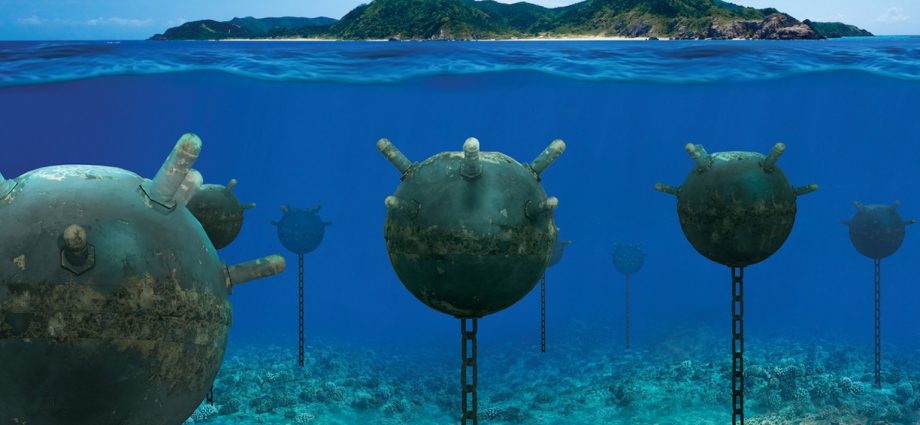Australia is set to buy smart sea mines with a hard eye on China, a procurement most likely driven by changing notions of sea control, unclear prospects of acquiring nuclear submarines under AUKUS and renewed interest in having indigenous mine warfare capabilities.
This week, Sydney Morning Herald (SMH) reported that Australia will spend up to US$698 million to purchase an unspecified number of smart sea mines from an unnamed European unmanned weapons supplier; Italy and Spain are Europe’s leading sea mine manufacturers.
The report states that the Australian Department of Defense (DOD) intends to purchase sophisticated multi-influence seabed mines that are triggered by acoustic, magnetic and pressure signatures of passing warships and can be turned on and off to allow the passage of friendly ships.
“Defense is accelerating the acquisition of smart sea mines, which will help to secure sea lines of communication and protect Australia’s maritime approaches… A modern sea mining capability is a significant deterrent to potential aggressors,” said the Australian DOD in a statement.
Retired Australian naval officer and mine warfare expert Greg Mapson notes in the SMH report that sea mines sunk more ships in World War II than all other means combined, describing them as “the most effective weapons system ever deployed in maritime warfare.”
“The sea mine is an incredibly flexible weapon system, offering both offensive and defensive options to government,” Mapson adds.
He also emphasizes the psychological effect of sea mines, noting that “they can lay in wait on the seabed for months, are incredibly difficult to find once they are laid and are always waiting for a potential victim to stray too close.”

Although the SMH report does not mention how many smart sea mines Australia intends to purchase, Mapson says 1,000 units would be an optimal number to deter adversaries. The same report notes that using sea mines is allowed under international law, but free-floating contact mines are banned.
As such, smart sea mines may be an effective means of enforcing selective sea control. James Goldrick writes in a September 2021 article in The Interpreter that sea control is not about being able to control the sea for its sake but rather using it to the extent necessary to achieve the movement needed, including securing the passage of a single ship.
Goldrick underscores the reality that Australia cannot defend its territory even in the short term without secure access to external resources, most notably oil. He also points out that during a major conflict, Australia would need to reduce importing materials by sea to a bare minimum.
Goldrick points out that if Australia’s F-35s could not be filled with the tons of fuel they need to carry out long-range strikes, the country’s northern air bases would be essentially defenseless.
The same strategic logic would apply to Australia’s surface fleet and conventional submarines, leaving Australia’s northern sea lanes of communication (SLOC) vulnerable.
However, he emphasizes that Australia can achieve a constant naval presence not just through surface assets but rather through a complex combination of space, land-based, airborne and seaborne systems.
At the same time, it is still not clear whether Australia’s plan to acquire nuclear submarines under the AUKUS alliance will come to fruition. In a September 2022 article for The Interpreter, Sam Roggeveen raises the implausibility of Australia acquiring nuclear submarines from the US or UK by even the late 2030s.
Asia Times has previously reported on the deal’s political, operational, and technological challenges. For example, if Australia chooses to lease a US Virginia-class nuclear submarine, it will most likely need a US crew aboard to operate it.

That would keep the submarine under US control and may be unacceptable to Australian defense planners. In addition, there are no clear terms regarding technology-sharing, how much Australian labor would go into building new nuclear submarines and the extent of Australia’s needs in terms of nuclear infrastructure.
Roggeveen writes that Australia’s nuclear submarine plan may be driven more by prestige than practical reasons, as Canberra seeks to join the ranks of leading global naval powers by operating the apex predator of naval warfare.
He mentions that while the acquisition of US nuclear submarines will further deepen the already profound alliance between the two sides, the purchase will make it harder for Australia to chart an independent course if in the future it disagrees with Washington’s policy direction.
Roggeveen also highlights the lack of publicly available information regarding Australia’s plans to acquire nuclear submarines under AUKUS, emphasizing that the Australian public deserves to know the strategic implications of possessing a weapon aimed explicitly at China.
Asia Times has previously reported that Australia’s mine warfare capabilities will mitigate its security dependence on the US, allowing it to defend itself should the US be unwilling or unable to assist.
Acquiring more sea mines may also plug-in capability gaps in the US-Australia alliance, as mine warfare is currently a neglected capability in both countries’ navies. Moreover, Australia can opt to manufacture its own sea mines in a move to boost its domestic defense industries.

While Australia’s acquisition of nuclear submarines under AUKUS may or may not come to pass, improving its mine warfare capabilities will provide the persistent deterrent presence that nuclear submarines give at a fraction of the cost.
Mapson, in an October 2021 article for The Strategist, notes that Australia needs a considerable arsenal of influence and advanced encapsulated torpedo mines that can be delivered from aircraft, ships, and submarines for its deterrence.
Apart from defensive mining, Mapson mentions that unmanned underwater vehicles (UUV) can perform offensive mining operations in enemy ports and waterways.

